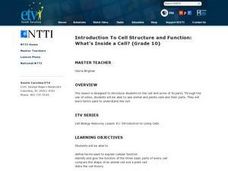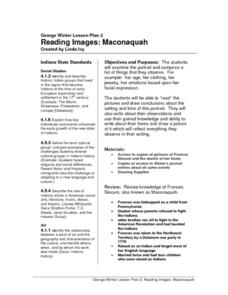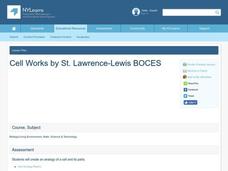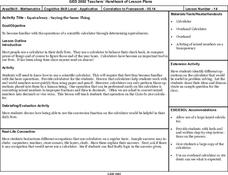Curated OER
"Write" Answers
Students examine the Q.& A. articles found each week in Science Times, focusing on how the answers are presented in a clear and logical way, as well as the relevance of understanding science's roles in our daily lives.
Curated OER
Who Needs It?
Fourth graders explain the needs and wants of an Abenaki family or group and/or of a family or group in the first half of the 19th century and compare them to the needs and wants of Students' family or household today.
Curated OER
Economics: The Scarcity Principle
Students discover how scarcity leads to economic choices. They examine its effect on individuals, business, and governments. Students simulate various scenarios to determine the role scarcity plays in each.
Curated OER
Properties of Matter
Second graders investigate how objects can be described, classified and compared by their composition. They recognize that the same material can exist in different states. Students verify that things can be done to materials to change...
Curated OER
One Step At A Time
Students begin the lesson by discussing how two people watching the same event can see it differently. After viewing an overhead transparency, they report on what they saw after being called upon. They discover that what we see is our...
Curated OER
Introduction To Cell Structure and Function: What's Inside a Cell?
Tenth graders are introduced to the cell and some of its parts. Through the use of video, 10th graders see animal and plants cells and their parts. They learn terms used to explain the cell.
Curated OER
Heroes With Heart
Students study women and minority figures who have contribute to the common good of civil society. In this women and minority figure lesson, students listen to a recording of "Hero" by Mariah Carey. They work in small groups to research...
Curated OER
Checkbook
Pupils examine how to balance a checkbook. In this economics lesson, students demonstrate that they can balance a checkbook by completing an activity that includes a check register and bank statement.
Curated OER
Cave Art: Discovering Prehistoric Humans through Pictures
Students explore how people in earlier times used art as a way to record stories and communicate ideas. By studying paintings from the Cave of Lascaux and other caves in France, students discover that pictures are more than pretty colors.
Curated OER
Layers of the Earth
Third graders examine the layers of the earth during a teacher led discussion. They listen to a read aloud of "How to Dig a Hole to the Other Side of the World," as they "visit" each layer. They work a worksheet while small groups design...
Curated OER
Model Volcanoes
Students discover what causes earthquakes, volcanoes and floods. Using this information, they discuss how these natural disasters change the surface of the Earth. In groups, they make models, draw pictures and make them erupt.
Curated OER
Insect Food Chain & Camouflage
Students use art work to demonstrate their understanding of the insect food chain and their ability to camouflage themselves. In this insect food chain and camouflage lesson, students determine what type of animals feed on insects. They...
Curated OER
Reading Images: Maconaquah
Students examine a portrait of Maconaquah and compose a list of things they observe about her. They look at her age, clothing, jewelry, and her emotions based on her facial expression. Conclusions are drawn as they "read" the pictures...
Curated OER
Bean There, Done Plant
Students explain that events in nature follow an orderly progression when they plant seeds and observe the development of the seeds. They count seeds and find the likenesses and the differences of many seeds.
Curated OER
Your Place in Time Scavenger Hunt
Fifth graders divide themselves into groups of 3 or 4, research 4 different generations, and answer the questions on the handout provided. They then work in cooperative groups to create a poster illustrating their generation.
Curated OER
Applied Science - Technology Pre - Lab (inventions)
Students read the book Icky, Sticky Gloop by Morgan Matthes. In this scientific exploration lesson, students compare the fictional character in the book with Benjamin Franklin (both are inventors). They discover why and how inventions...
Curated OER
Sticks and Stones
Second graders discuss bullying and list ways on how they can help reduce bullying amongst their peers. In this bullying lesson plan, 2nd graders also reflect on their own experiences and write journal entries about them.
Curated OER
Map Keys
Third graders examine maps and map keys. For this locating map features lesson, 3rd graders use crayons, markers and colored pencils to label maps. Students work in partners to read map keys and locate given places and things.
Curated OER
Under The Sea
Second graders study how a tsunami is formed by underwater events such as earthquakes, volcanoes or landslides. They discuss what they knew about living and non-living things in the ocean.
Curated OER
Frog Metamorphosis
Students play 20 Questions with animal characteristics and then view an animation of how a tadpole changes into a frog. They consider the importance of camouflage to frogs and write out the story of a frog from tadpole to adult.
Curated OER
Project Based Learing: Social Responsibility
Young scholars explore social responsibility. In this service learning lesson, students participate in 4 weekly activities that require them to research "communitarians", write poems about their contributions, and create works of art...
Curated OER
Cell Works
Young scholars identify the different parts of the cells and their functions. In this biology lesson plan, students create an analogy of a cell and its organelles. They make a poster and present it to class.
Curated OER
Equivalency-Saying the Same Thing
Fifth graders use a scientific calculator to practice finding equivalencies They discuss the possible uses for the scientific calculator. They experiment with other basic functions using the calculator.
Curated OER
How To Get the Job Done
Fifth graders identify the physical activities that are related to certain jobs.

























